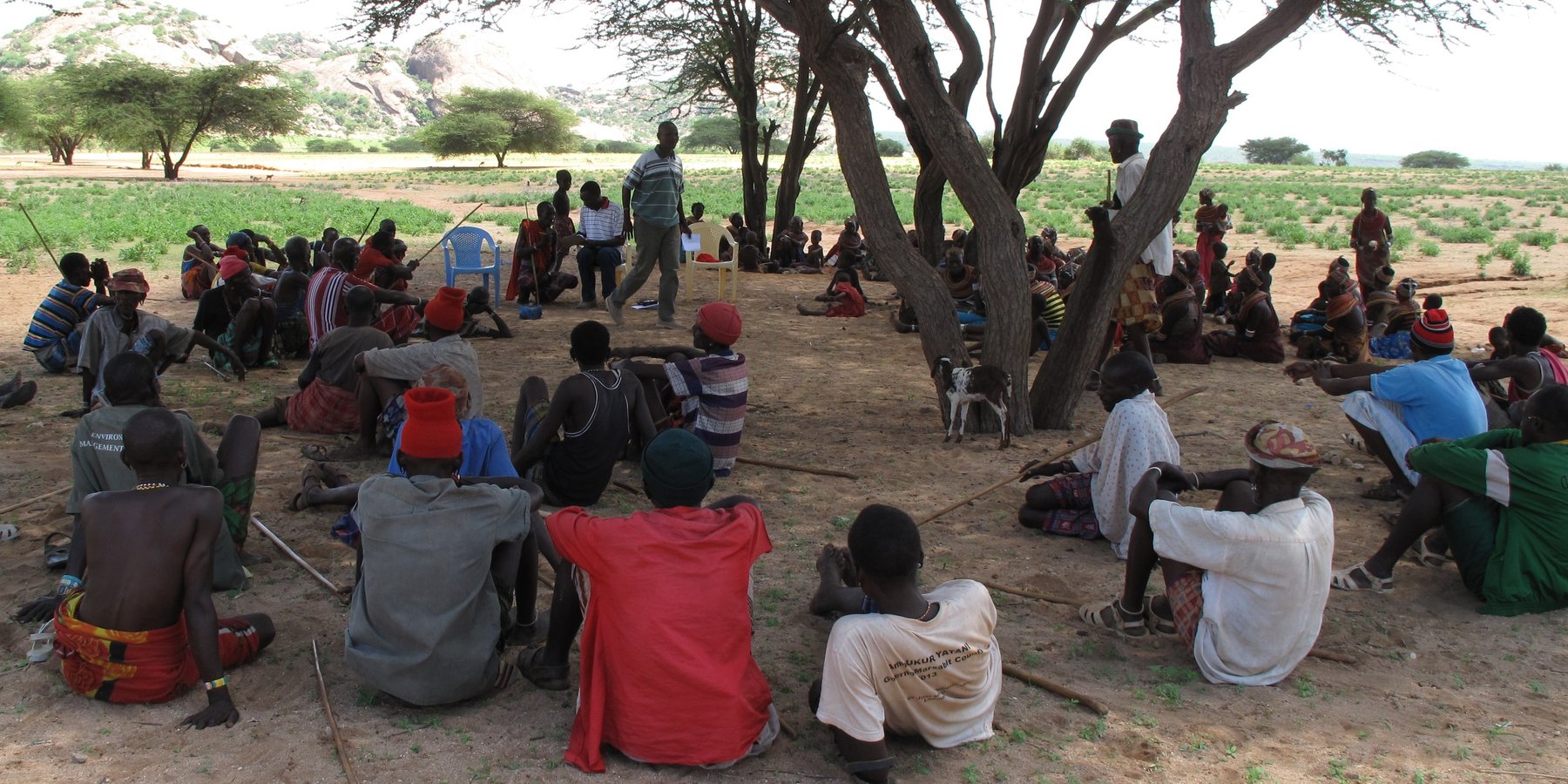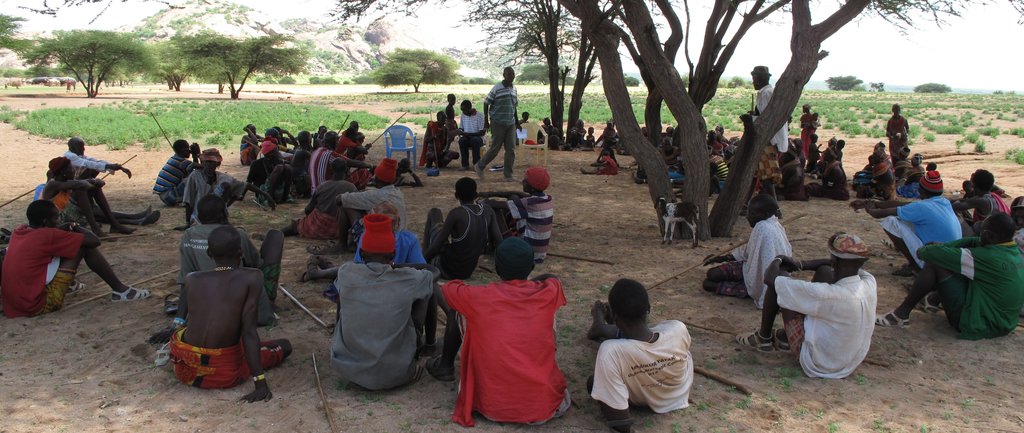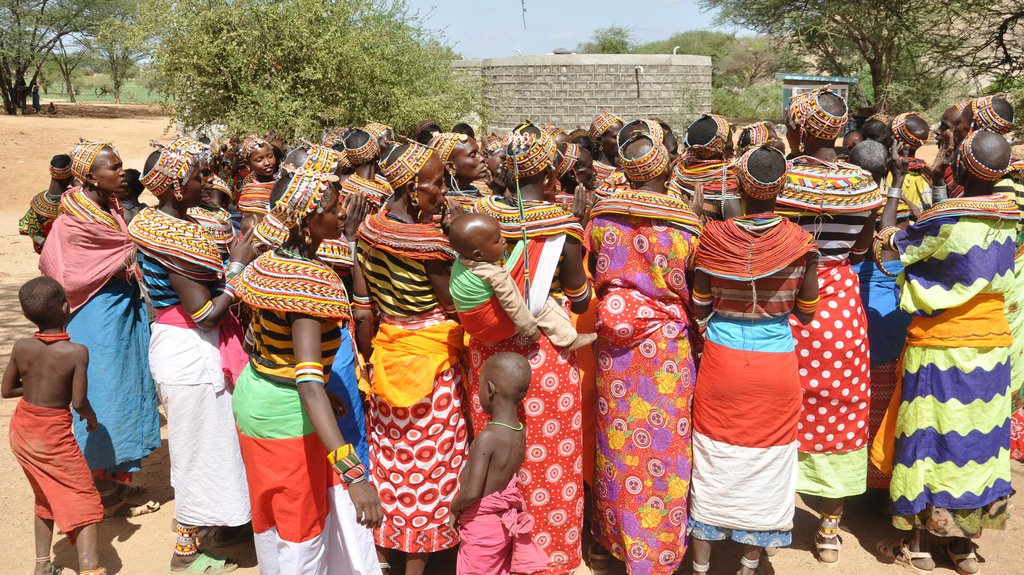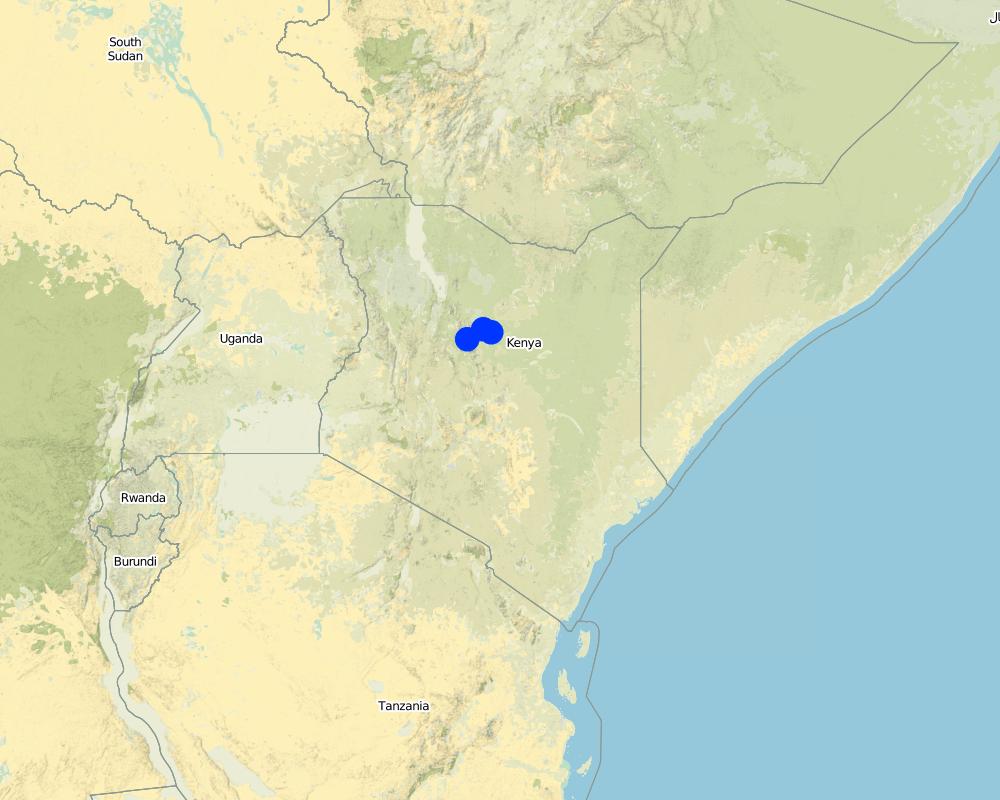Partnership with beneficiary communities in project implementation [ប្រទេសកេនយ៉ា]
- ការបង្កើត៖
- បច្ចុប្បន្នភាព
- អ្នកចងក្រង៖ Fredrick Ochieng
- អ្នកកែសម្រួល៖ Boris Orlowsky, Nicole Stolz
- អ្នកត្រួតពិនិត្យច្រើនទៀត៖ Renate Fleiner, Boris Orlowsky, Alexandra Gavilano
N/A
approaches_597 - ប្រទេសកេនយ៉ា
ពិនិត្យមើលគ្រប់ផ្នែក
ពង្រីកមើលទាំងអស់ បង្រួមទាំងអស់1. ព័ត៌មានទូទៅ
1.2 ព័ត៌មានលម្អិតពីបុគ្គលសំខាន់ៗ និងស្ថាប័នដែលចូលរួមក្នុងការវាយតម្លៃ និងចងក្រងឯកសារនៃវិធីសាស្ត្រផ្សព្វផ្សាយ
បុគ្គលសំខាន់ម្នាក់ (ច្រើននាក់)
Fredrick Ochieng:
ប្រទេសកេនយ៉ា
ឈ្មោះអង្គភាពមួយ (ច្រើន) ដែលបានចងក្រងឯកសារ/ វាយតម្លៃលើវិធីសាស្ត្រផ្សព្វផ្សាយ (បើទាក់ទង)
CARITAS (Switzerland) - ប្រទេសស្វ៊ីស1.3 លក្ខខណ្ឌទាក់ទងទៅនឹងការប្រើប្រាស់ទិន្នន័យដែលបានចងក្រងតាមរយៈវ៉ូខេត
តើពេលណាដែលទិន្នន័យបានចងក្រង (នៅទីវាល)?
14/10/2016
អ្នកចងក្រង និង(បុគ្គលសំខាន់ៗ)យល់ព្រមទទួលយកនូវលក្ខខណ្ឌនានាទាក់ទងទៅនឹងការប្រើប្រាស់ទិន្នន័យដែលបានចងក្រងតាមរយៈ វ៉ូខេត:
បាទ/ចា៎
1.4 ការយោងមួយ (ច្រើន) ទៅលើ (កម្រង) បញ្ជីសំណួរនៃបច្ចេកទេស SLM
2. ការពណ៌នាអំពីវិធីសាស្ត្រផ្សព្វផ្សាយ SLM
2.1 ពណ៌នាសង្ខេបខ្លីពីវិធីសាស្ត្រផ្សព្វផ្សាយ
The approach focuses on community engagement on a partnership basis. The model is a departure from the traditional approaches where the community mostly is reduced to being a beneficiary of project services without substantive responsibility.
2.2 ពណ៌នាលម្អិតពិវិធីសាស្ត្រផ្សព្វផ្សាយ
ពណ៌នាលម្អិតពិវិធីសាស្ត្រផ្សព្វផ្សាយ:
The Approach is hinged on community empowerment and partnership. The model is a departure from the traditional approaches where the community is reduced to a mere beneficiary of project services without substantive responsibility.
The main purpose of the approach is to enhance ownership, while fostering needed capacity for management of project outcomes. Ultimately, it is estimated that sustainability of project results is achievable with good community empowerment and meaningful participation. The approach also aims at cost effectiveness as the community is required to substantially contribute locally available materials, labour and sometimes cash.
Community mobilisation and capacity building is central to ensure that the community is prepared to undertake their roles and responsibilities. Mobilisation happens through discussions, sometimes aided by applying participatory tools and methods. Capacity building is done through workshop-type and/or on-the-job training. It is noteworthy that the communities do have indigenous knowledge and skills which are useful in processes of development at the community level. These skills and knowledge inform the project design, planning and implementation of activities. To enhance local skills, selected community members are trained as they work alongside the hired skilled artisans during the construction of the rock catchment system. The aim is to prepare and equip the locals with basic skills for operations and maintenance of the rock catchment system. Others are trained to get equipped with skills on hygiene and sanitation promotion.
The project was designed based on pre-project assessment. The assessment, besides identifying water and hygiene needs, also identified three areas/communities which had rock catchment potential - Ndikir, Manyatta Lengima and Mpagas. Initial meetings were done with support from community leaders and the local government administrators (chiefs). During the meetings the project was explained and discussed in view of the community needs and the roles for all stakeholders - Caritas Switzerland (CACH), the community, government and leaders. Agreed roles and responsibilities were drafted and formed the main part of the memorandum of understanding (MOU) between CACH and the community. The MOU was signed before the entire community for collective ownership and formalise the relationship between CACH and the project.
At the county and sub-county level, the stakeholders are provided with progress updates, engaging with government and other leaders. The local leaders were useful in helping in community mobilisation and addressing areas of concern wherever issues arose.
The approach left the community more motivated with a desire to manage the project benefits for posterity. The community has appreciated that the project ended with a number of community members having acquired basic skills for operations and maintenance. Above all, they were proud that they significantly contributed to the successful implementation of the project. Initially the community were opposed to the idea that they had to contribute so much, since before they had mostly received assistance without any requirement on their side to contribute.
2.3 រូបភាពនៃវិធីសាស្ត្រផ្សព្វផ្សាយ
2.4 វីឌីអូនៃវិធីសាស្ត្រផ្សព្វផ្សាយ
ការពណ៌នាសង្ខេប:
The video is taken on an early morning shower and shows how water is collected, dammed and channelled downstream to the masonry tanks.
កាលបរិច្ឆេទ:
08/12/2014
ទីតាំង:
Ndikir village, Marsabit County, Kenya
ឈ្មោះអ្នកថតវីឌីអូ:
Fredrick Ochieng
2.5 ប្រទេស/តំបន់/ទីតាំងកន្លែង ដែលវិធីសាស្ត្រផ្សព្វផ្សាយត្រូវបានអនុវត្តន៍
ប្រទេស:
ប្រទេសកេនយ៉ា
តំបន់/រដ្ឋ/ខេត្ត:
Laisamis sub county, Marsabit County, Kenya
បញ្ជាក់បន្ថែមពីលក្ខណៈនៃទីតាំង:
Implemented with three different communities in three locations, Ndikir, Manyatta Lengima and Mpagas
Map
×2.6 កាលបរិច្ឆេទនៃការចាប់ផ្តើម និងបញ្ចប់នៃវិធីសាស្រ្តផ្សព្វផ្សាយនេះ
សូមបញ្ជាក់ឆ្នាំដែលបានបង្កើតឡើង:
2013
ឆ្នាំបញ្ចប់ (ប្រសិនបើវិធីសាស្ត្រផ្សព្វផ្សាយត្រូវបានឈប់ប្រើប្រាស់):
2015
មតិយោបល់:
The Rock catchment project was implemented from 2013 to 2015
2.7 ប្រភេទនៃវិធីសាស្ត្រផ្សព្វផ្សាយ
- ផ្អែកលើគម្រោង/កម្មវិធី
2.8 គោលបំណង/ទិសដៅសំខាន់នៃវិធីសាស្ត្រផ្សព្វផ្សាយ
1. Community mobilisation
2. Active community participation and ownership of the project and outcomes
3. Sustainability of the project outcomes
4. Enhanced skills and capacity to manage the Technology
2.9 លក្ខខណ្ឌអនុញ្ញាត ឬរារាំងការអនុវត្តន៍បច្ចេកទេសដែលស្ថិតនៅក្រោមវិធីសាស្រ្តផ្សព្វផ្សាយ
សង្គម/វប្បធម៌/ និងតម្លៃនៃសាសនា
- រារាំង
The community was accustomed to receiving food and non-food handouts. This culture was a major huddle in working with community where they were expected to make substantial contribution towards the project activities.
បរិបទនៃស្ថាប័ន
- អំណោយផល
The institutional setting, especially the traditional authority of elders, was supportive during implementation. Once the elders were convinced and persuaded to make certain decisions beneficial to the project, it was always easier for the rest of the community members to rally behind.
ការសហការ/ការសម្របសម្រួលតួអង្គពាក់ព័ន្ធ
- អំណោយផល
The Approach requires that stakeholders (other non-state actors and government) coordinate well so that approaches employed by all are complementary and all build into sustainable results. It is common however that there have been approaches that dis-empower communities. Good coordination and collaboration would enhance sharing and learning across the actors and minimise such programming pitfalls.
ក្របខណ្ឌច្បាប់ (សិទ្ធិកាន់កាប់ដីធ្លី កម្មសិទ្ធីប្រើប្រាស់ដីនិងទឹក)
- អំណោយផល
Land tenure in the northern Kenya is mostly communal. This was an enabling factor so that there were no complex and usual elaborate and expensive legal requirements to construct a rock catchment water system. Had land been adjudicated and subdivided for individual ownership, there would have been a need for negotiations and legal procedures to be done with those who own the land where the public asset is to be located.
3. ការចូលរួម និងតួនាទីរបស់ភាគីពាក់ព័ន្ធ
3.1 អ្នកពាក់ព័ន្ធដែលបានចូលរួមក្នុងវិធីសាស្ត្រផ្សព្វផ្សាយ និងតួនាទីរបស់ពួកគេ
- អ្នកប្រើប្រាស់ដីក្នុងតំបន់/សហគមន៍
The project was implemented with participation of the communities who are the local land users
Community's role was to ensure that locally available materials were delivered on the site of construction, hygiene and sanitation promotion, unskilled labour, record keeping of all construction materials, security of workers and construction materials on site
- អ្នកឯកទេសគ្រប់គ្រងដីប្រកបដោយចីរភាព/ទីប្រឹក្សាបច្ចេកទេសកសិកម្ម
Caritas had a technical team of three staff who were based within the project location in the field. This team was supported through experts in the office in the capital city Nairobi.
The technical team implemented all project activities such as community organisation/mobilisation, construction of infrastructure as well as hygiene and sanitation promotion.
- រដ្ឋាភិបាលថ្នាក់មូលដ្ឋាន
Chiefs, Members of County Assembly, Ward administrators
Opinion leaders were critical in the process of community mobilisation and following-up the commitments made by the community under the signed MoU.
- រដ្ឋាភិបាលថ្នាក់ជាតិ (អ្នករៀបចំផែនការ អ្នកសម្រេចចិត្ត)
County Steering Group (CSG), sub-County Steering Group (SCSG)
Coordination with other development agencies and government departments at the County level
- អង្គការអន្តរជាតិ
Caritas Switzerland
Overall leadership in project planning, implementation and supervision
3.2 ការចូលរួមរបស់អ្នកប្រើប្រាស់ដីក្នុងតំបន់/ សហគមន៍ក្នុងតំបន់ក្នុងដំណាក់កាលផ្សេងគ្នានៃវិធីសាស្រ្តផ្សព្វផ្សាយ
| ការចូលរួមរបស់អ្នកប្រើប្រាស់ដីក្នុងតំបន់/សហគមន៍ក្នុងតំបន់ | សូមបញ្ជាក់នរណាត្រូវបានចូលរួម ព្រមទាំងពណ៌នាសកម្មភាពទាំងនោះ | |
|---|---|---|
| ការចាប់ផ្តើម/ការលើកទឹកចិត្ត | អន្តរកម្ម | Planning for project activities was jointly planned between the community and the project staff specialists |
| ការរៀបចំផែនការ | អន្តរកម្ម | More technical planning was done as advised by the technical project team. Planning for day to day field activities during implementation was jointly done with the community |
| ការអនុវត្តន៍ | អន្តរកម្ម | Community participation was more interactive in planning for specific project activities. However, there were specific tasks which required hired labour and by common agreement the community provided such labour for payment. |
| ការត្រួតពិនិត្យ និងវាយតម្លៃ | អន្តរកម្ម | Monitoring with community was mainly done during project reflection/review meetings. Monitoring in this respect was more limited to evaluation of project activities progress and timeliness with which the activities were being achieved. |
3.3 គំនូសបំព្រួញ (ប្រសិនបើមាន)
ការពណ៌នា:
The flow chart summarises the Approach's key components, activities and steps for community mobilisation, capacity building and stakeholders engagement. The stakeholders include the relevant government departments - Water, Health, Environment, Drought Management - and non-state actors in the County. There is a monthly forum known as the County Steering Group (CSG) which brings together all the heads of government departments and NGO representatives at the county level. Similar forums also take place at the sub-county level.
អ្នកនិពន្ធ:
Fredrick Ochieng
3.4 ការសម្រេចចិត្តលើការជ្រើសរើសបច្ចេកទេស SLM
សូមបញ្ជាក់តើអ្នកណាជាអ្នកបានសម្រេចចិត្តក្នុងការជ្រើសរើសបច្ចេកទេសដើម្បីយកមកអនុវត្តន៍:
- គ្រប់ភាគីពាក់ព័ន្ធទាំងអស់ដែលជាផ្នែកនៃវិធីសាស្រ្តផ្សព្វផ្សាយដោយមានការចូលរួម
ចូរពន្យល់:
The project was designed initially without direct community involvement other than the pre-project information collected.
សូមបញ្ជាក់ តើការសម្រេចធ្វើឡើងដោយផ្អែកលើអ្វីជាមូលដ្ឋាន:
- វាយតម្លៃទៅលើចំណេះដឹងស្តីអំពី SLM ដែលបានចងក្រងជាឯកសារបានត្រឹមត្រូវ (ផ្អែកលើភស្តុតាងជាមូលដ្ឋានដើម្បីសម្រេចចិត្ត)
- លទ្ធផលបានពីការស្រាវជ្រាវ
- បទពិសោធន៍ និងគំនិតផ្ទាល់ខ្លួន(ពុំមានចងក្រងជាឯកសារ)
- Government policies
4. ជំនួយបច្ចេកទេស ការកសាងសមត្ថភាព និងការគ្រប់គ្រងចំណេះដឹង
4.1 ការកសាងសមត្ថភាព/ បណ្តុះបណ្តាល
តើវគ្គបណ្តុះបណ្តាលបានផ្តល់ឱ្យអ្នកប្រើប្រាស់ដី/អ្នកពាក់ព័ន្ធផ្សេងៗទៀតដែរឬទេ?
បាទ/ចា៎
សូមបញ្ជាក់តើអ្នកណាត្រូវបានបណ្តុះបណ្តាល:
- អ្នកប្រើប្រាស់ដី
- បុគ្គលិកចុះទីវាល/អ្នកផ្តល់ប្រឹក្សាយោបល់
ទម្រង់នៃការបណ្តុះបណ្តាល:
- អនុវត្តន៍ជាមួយការងារ
- ទីតាំងបង្ហាញ
ប្រធានបទបណ្តុះបណ្តាល:
Basic construction skills, management of water system (rock catchment), hygiene and sanitation promotion
4.2 សេវាផ្តល់ប្រឹក្សាយោបល់
តើអ្នកប្រើប្រាស់ដីបានទទួលនូវសេវាផ្តល់ប្រឹក្សាដែរ ឬទេ?
បាទ/ចា៎
សូមបញ្ជាក់ប្រសិនបើសេវាកម្មប្រឹក្សាយោបល់ត្រូវបានផ្តល់ឱ្យ:
- នៅលើដីរបស់អ្នកប្រើប្រាស់ដី
ពណ៌នា/ពន្យល់:
The community has (in theory) access to government advisory services. However, the nearest government offices are about 20-50 kilometres away without reliable means of transport. The technical staff of the county government is often unable to offer quality and effective extension work, mostly due to transport limitations but also due to low motivation. However, this gap is being bridged through the work of various NGOs operating in the region who provide advisory services in addition to other interventions such as in water, health, livelihoods, and education.
4.3 ការពង្រឹងសមត្ថភាពស្ថាប័ន (ការអភិរឌ្ឍន៍អង្គភាព)
តើស្ថាប័នទាំងអស់ត្រូវបានបង្កើតឡើង ឬពង្រឹងសមត្ថភាពតាមរយៈវិធីសាស្ត្រផ្សព្វផ្សាយដែរ ឬទេ?
- បាទ/ច៎ា ជាមធ្យម
សូមបញ្ជាក់ថាតើស្ថាប័នត្រូវបានពង្រឹង ឬបង្កើតឡើងនៅត្រឹមកម្រិតណា(ច្រើន)?
- ថ្នាក់មូលដ្ឋាន
ចូពណ៌នាពីស្ថាប័ន តួនាទី និងទំនួលខុសត្រូវ សមាជិក ។ល។:
The Approach led to establishment of Water Management Committees. The committees have been trained and equipped to manage the systems.
សូមបញ្ជាក់ប្រភេទនៃការគាំទ្រ:
- ហិរញ្ញវត្ថុ
- ការកសាងសមត្ថភាព/ បណ្តុះបណ្តាល
- សម្ភារៈ
សូមផ្តល់ព័ត៌មានបន្ថែមទៀតឱ្យបានលម្អិត:
One key lesson from this and other projects is that one-off trainings are rarely effective even if properly done. A continuous support/follow-up is necessary to maintain the skills and knowledge acquired.
4.4 ការត្រួតពិនិត្យ និងវាយតម្លៃ
តើការត្រួតពិនិត្យ និងវាយតម្លៃគឺជាផ្នែកមួយនៃវិធីសាស្ត្រដែរឬទេ?
ទេ
4.5 ការស្រាវជ្រាវ
តើការស្រាវជ្រាវ គឺជាផ្នែកមួយនៃវិធីសាស្រ្តដែរឬទេ?
ទេ
5. ថវិកា និងសម្ភារៈឧបត្ថម្ភពីខាងក្រៅ
5.1 ថវិកាប្រចាំឆ្នាំសម្រាប់ផ្សព្វផ្សាយ SLM
ប្រសិនបើចំនួនពិតប្រាកដនៃថវិកាប្រចាំឆ្នាំមិនត្រូវបានដឹងច្បាស់ សូមប្រាប់ពីចន្លោះនៃថវិកានោះ:
- 2,000-10,000
មតិយោបល់ (ឧ. ប្រភពសំខាន់នៃមូលនិធិ/ម្ចាស់ជំនួយចំបង):
Internal organisational funding and external donors
5.2 ការគាំទ្រផ្នែកហិរញ្ញវត្ថុ / សម្ភារៈដែលបានផ្តល់ទៅឱ្យអ្នកប្រើប្រាស់ដី
តើអ្នកប្រើប្រាស់ដីបានទទួលការគាំទ្រផ្នែកហិរញ្ញវត្ថ/សម្ភារៈសម្រាប់ការអនុវត្តន៍បច្ចេកទេសដែរឬទេ:
បាទ/ចា៎
ប្រសិនបាទ/ច៎ា សូមបញ្ជាក់ប្រភេទ(ច្រើន)នៃការគាំទ្រ លក្ខខណ្ឌ និងអ្នកផ្តល់ឱ្យ(ច្រើន):
Caritas procured the bulk of construction materials whereas the community contributed locally available materials - sand and hardcore stones
5.3 សូមបញ្ជាក់ពីធាតុចូលត្រូវបានផ្តល់បដិភាគ (រួមទាំងកម្លាំងពលកម្ម)
ប្រសិនបើកម្លាំងពលកម្មធ្វើដោយអ្នកប្រើប្រាស់ដី តើវាជាធាតុចូលដ៏សំខាន់មួយដែរ ឬទេ:
- ដោយស្ម័គ្រចិត្ត
មតិយោបល់:
The labour contribution was split between the organisation and the community. Caritas paid 3 USD per day whereas the standard amount per day is 5 USD. This was discussed and agreed at the inception of the project. The consideration was that those who work on site will not have any other time for other work for their household daily needs.
5.4 ឥណទាន
តើឥណទានដែលបានផ្តល់នៅក្រោមវិធីសាស្ត្រផ្សព្វផ្សាយសម្រាប់សកម្មភាព SLM នេះយ៉ាងដូចម្តេច?
ទេ
5.5 ការលើកទឹកចិត្ត ឬវិធីសាស្ត្រដ៏ទៃទៀត
តើមានការលើកទឹកចិត្តផ្សេងទៀត ឬឧបករណ៍ប្រើប្រាស់ដើម្បីលើកកម្ពស់ការអនុវត្តន៍បច្ចេកទេស SLM?
ទេ
6. ការវិភាគរកផលប៉ះពាល់ និងសេចក្តីសន្និដ្ឋាន
6.1 ផលប៉ះពាល់នៃវិធីសាស្ត្រផ្សព្វផ្សាយ
តើវិធីសាស្ត្រផ្សព្វផ្សាយបានផ្តល់សិទ្ធិអំណាចដល់អ្នកប្រើប្រាស់ដី ធ្វើឱ្យប្រសើរឡើងនូវការចួលរួមអ្នកពាក់ព័ន្ធ?
- ទេ
- បាទ/ច៎ា បន្តិចបន្តួច
- បាទ/ច៎ា ជាមធ្យម
- បាទ/ច៎ា បានខ្លាំង
Community's participation was initially a new concept for the communities in this region. Through various meetings, persistency and flexibility the community participation improved and was achieved during the project period.
តើវិធីសាស្រ្តផ្សព្វផ្សាយនេះអនុញ្ញាតឱ្យធ្វើការសម្រេចចិត្ដដោយផ្អែកលើភស្តុតាងជាមូលដ្ឋានដែរ ឬទេ?
- ទេ
- បាទ/ច៎ា បន្តិចបន្តួច
- បាទ/ច៎ា ជាមធ្យម
- បាទ/ច៎ា បានខ្លាំង
Due to the nature of working with the community, it was always possible to review certain elements of project activities based on learning
តើវិធីសាស្ត្រផ្សព្វផ្សាយជួយអ្នកប្រើប្រាស់ដីដើម្បីអនុវត្តន៍ និងថែទាំបច្ចេកទេស SLM?
- ទេ
- បាទ/ច៎ា បន្តិចបន្តួច
- បាទ/ច៎ា ជាមធ្យម
- បាទ/ច៎ា បានខ្លាំង
The Approach's aim was to build the required capacity of the community members to better manage the Technology well after the project ends.
តើវិធីសាស្រ្តផ្សព្វផ្សាយនេះធ្វើឱ្យប្រសើរឡើងនូវការសម្របសម្រួលនិងការអនុវត្តចំណាយរបស់ SLMមានប្រសិទ្ធិភាពបែបណា? :
- ទេ
- បាទ/ច៎ា បន្តិចបន្តួច
- បាទ/ច៎ា ជាមធ្យម
- បាទ/ច៎ា បានខ្លាំង
Community's contribution in labour and locally available materials (hardcore stones and sand) significantly reduced the cost of construction. These are materials that otherwise would have been procured from far off sources at a much higher cost.
តើវិធីសាស្រ្តផ្សព្វផ្សាយនេះប្រមូលផ្តុំ / ធ្វើឱ្យប្រសើរឡើងនូវការទទួលបានធនធានហិរញ្ញវត្ថុសម្រាប់ការអនុវត្ត SLM?
- ទេ
- បាទ/ច៎ា បន្តិចបន្តួច
- បាទ/ច៎ា ជាមធ្យម
- បាទ/ច៎ា បានខ្លាំង
The SLM was implemented with funding support aimed for drought recovery. The country had just gone through a major drought. The Approach, however, focused more on mobilising communities towards meaningful participation by providing local available resources such as hardcore, sand, and unskilled labour.
តើវិធីសាស្ត្រផ្សព្វផ្សាយនេះធ្វើឱ្យចំណេះដឹងប្រសើឡើង និងសមត្ថភាពរបស់អ្នកប្រើប្រាស់ដីក្នុងការអនុវត្តន៏ SLM?
- ទេ
- បាទ/ច៎ា បន្តិចបន្តួច
- បាទ/ច៎ា ជាមធ្យម
- បាទ/ច៎ា បានខ្លាំង
A significant element of the Approach was capacity building which was achieved through on-the-job and workshop training for the selected community members
តើវីធីសាស្ត្រផ្សព្វផ្សាយនេះពង្រឹងចំណេះដឹង និងកសាងសមត្ថភាពរបស់អ្នកពាក់ព័ន្ធឬទេ?
- ទេ
- បាទ/ច៎ា បន្តិចបន្តួច
- បាទ/ច៎ា ជាមធ្យម
- បាទ/ច៎ា បានខ្លាំង
The project was implemented with close involvement of county government officials and other development organisations. There have been requests by other development actors in the region wanting to know more about how Caritas Switzerland succeeded in working with the communities and achieving these impressive results.
តើវីធីសាស្ត្រនេះបានជួយកសាង/ពង្រឹងស្ថាប័ន កិច្ចសហប្រតិបត្តិការរវាងអ្នកពាក់ព័ន្ធដែរ ឬទេ?
- ទេ
- បាទ/ច៎ា បន្តិចបន្តួច
- បាទ/ច៎ា ជាមធ្យម
- បាទ/ច៎ា បានខ្លាំង
The project's mandate was limited to community institutions capacity building. Beyond community empowerment the Approach did not target to raise capacity of other stakeholders.
តើវីធីសាស្ត្រផ្សព្វផ្សាយនេះបានកាត់បន្ថយជំលោះឬទេ?
- ទេ
- បាទ/ច៎ា បន្តិចបន្តួច
- បាទ/ច៎ា ជាមធ្យម
- បាទ/ច៎ា បានខ្លាំង
The region within which the project was implemented in has resource based conflicts, mostly conflicts over water and pasture land. The Approach led to successful implementation of the Technology which reduces pressure on water resources. In addition, the management of the newly constructed water points ensures that community members benefits equally
តើវិធីសាស្ត្រផ្សព្វផ្សាយនេះផ្តល់សិទ្ធិអំណាចដល់សង្គមនិងសេដ្ឋកិច្ចដែលក្រុមមិនទទួលបានផលប្រយោជន៍?
- ទេ
- បាទ/ច៎ា បន្តិចបន្តួច
- បាទ/ច៎ា ជាមធ្យម
- បាទ/ច៎ា បានខ្លាំង
Women are the main beneficiaries of the Approach. They were more active than men in offering semi-voluntary labour. Their motivation was that they bear the greater burden than men as it is their responsibility to provide household water .
តើវិធីសាស្ត្រផ្សព្វផ្សាយបានលើកទឹកចិត្តដល់អ្នកប្រើប្រាស់ដីដែលជាយុវជន/ក្មេងជំនាន់ក្រោយឱ្យចូលរួមក្នុង SLM ?
- ទេ
- បាទ/ច៎ា បន្តិចបន្តួច
- បាទ/ច៎ា ជាមធ្យម
- បាទ/ច៎ា បានខ្លាំង
Youth participation was minimal due cultural barriers. Young men do not participate in most of community activities. They are expected to have minimal contact with the rest, and especially women hence most of their time they are in the bush
តើវិធីសាស្ត្រផ្សព្វផ្សាយបានឱ្យប្រសើរឡើងនូវបញ្ហាកាន់កាប់ដីធ្លី/សិទ្ធិអ្នកប្រើប្រាស់ដែលរារាំងដល់ការអនុវត្ត SLM?
- ទេ
- បាទ/ច៎ា បន្តិចបន្តួច
- បាទ/ច៎ា ជាមធ្យម
- បាទ/ច៎ា បានខ្លាំង
Land tenure system in the area where the Approach was implemented is communal.
តើវិធីសាស្ត្រផ្សព្វផ្សាយនាំឱ្យប្រសើរឡើងនូវសន្តិសុខស្បៀង/ធ្វើឱ្យប្រសើរឡើងនូវអាហាររូបត្ថម្ភ?
- ទេ
- បាទ/ច៎ា បន្តិចបន្តួច
- បាទ/ច៎ា ជាមធ្យម
- បាទ/ច៎ា បានខ្លាំង
It is expected that nutritional status will improve with increased access to better quality water. However, no survey was carried out to confirm this assumption.
តើវិធីសាស្ត្រផ្សព្វផ្សាយធ្វើឱ្យប្រើសើរឡើងនូវការស្វែងរកទីផ្សារ?
- ទេ
- បាទ/ច៎ា បន្តិចបន្តួច
- បាទ/ច៎ា ជាមធ្យម
- បាទ/ច៎ា បានខ្លាំង
Community members who initially would spend substantial amount of time to search for water now have more time freed to engage in trade and other diversified sources of income
តើវិធីសាស្ត្រផ្សព្វផ្សាយនេះនាំឱ្យមានភាពប្រសើរឡើងក្នុងការទទួលបានទឹក និងអនាម័យ?
- ទេ
- បាទ/ច៎ា បន្តិចបន្តួច
- បាទ/ច៎ា ជាមធ្យម
- បាទ/ច៎ា បានខ្លាំង
There is improved access to water. The three benefiting communities no longer need water supply emergency. However, impact on sanitation was less than satisfactory.
តើវិធីសាស្ត្រផ្សព្វផ្សាយនេះនាំឱ្យមានកាប្រើប្រាស់ប្រកបដោយចីរភាព/ប្រភពនៃថាមពលកាន់តែប្រើសើរឡើង?
- ទេ
- បាទ/ច៎ា បន្តិចបន្តួច
- បាទ/ច៎ា ជាមធ្យម
- បាទ/ច៎ា បានខ្លាំង
The project's mandate under which the Approach was implemented was limited to water and sanitation
តើវិធីសាស្ត្របានធ្វើឱ្យប្រសើរឡើងនូវការកសាងសមត្ថភាពរបស់អ្នកប្រើប្រាស់ដីដើម្បីបន្សុំាទៅនឹងការប្រែប្រួលអាកាសធាតុ/អាកាសធាតុក្តៅហែង និងកាត់បន្ថាយគ្រោះមហន្តរាយទាក់ទឹងនឹងអាកាសធាតុ?
- ទេ
- បាទ/ច៎ា បន្តិចបន្តួច
- បាទ/ច៎ា ជាមធ្យម
- បាទ/ច៎ា បានខ្លាំង
Increased water supply has greatly increased community's resilience to droughts. With a prudent management of water harvested, they have successfully avoided negative drought impacts.
តើវិធីសាស្ត្រផ្សព្វផ្សាយនេះនាំឱ្យមានការងារ ឱកាសរកប្រាក់ចំណូល?
- ទេ
- បាទ/ច៎ា បន្តិចបន្តួច
- បាទ/ច៎ា ជាមធ្យម
- បាទ/ច៎ា បានខ្លាំង
There is no direct employment except that the community members can now engage more in other rewarding businesses
6.2 ការលើកទឹកចិត្តចម្បងៗរបស់អ្នកប្រើប្រាស់ដីសម្រាប់ការអនុវត្តបច្ចេកទេស SLM
- កាត់បន្ថយហានិភ័យនៃគ្រោះមហន្តរាយ
Increased water supply has greatly decreased community's vulnerability to droughts.
- កាត់បន្ថយទំហំការងារ
The community was highly motivated by the challenges of acute and perennial water shortages they have experienced for many years. They had a great desire to change and overcome this challenge.
- ការកាត់បន្ថយជម្លោះ
Reducing water scarcity likely leads to less conflict on water. However, no survey data is available to validate this assumption.
- improved water acess
6.3 សកម្មភាពផ្សព្វផ្សាយដែលប្រកបដោយចីរភាព
តើអ្នកប្រើប្រាស់ដីអាចធ្វើឱ្យមានចីរភាពនូវអ្វីដែលត្រូវបានអនុវត្តន៍តាមរយៈវិធីសាស្ត្រផ្សព្វផ្សាយដែរឬទេ(ដោយពុំមានការគាំទ្រពីអ្នកខាងក្រៅ)?
- បាទ/ចា៎
ប្រសិនបាទ/ច៎ា សូមរៀបរាប់ថាធ្វើយ៉ាងម៉េច:
The Approach greatly focused on capacity building, community empowerment and strengthened institutions. It is expected therefore that they will sustainably manage the Technologies that have been constructed.
6.4 ភាពខ្លាំង/ គុណសម្បត្តិនៃវិធីសាស្ត្រផ្សព្វផ្សាយ
| ភាពខ្លាំង/ គុណសម្បត្តិ/ ឱកាស ទស្សនៈរបស់អ្នកប្រើប្រាស់ដី |
|---|
| The Approach leads to greater ownership of the technology thus leading to better equipped community groups with skills for operations and maintenance. The Approach galvanises a community towards a common goal hence promotes cohesion and better organisation. |
6.5 ភាពខ្សោយ/ គុណវិបត្តិនៃវិធីសាស្ត្រ និងរកដំណោះស្រាយ
| ភាពខ្សោយ/ គុណវិបត្តិ/ ហានិភ័យ ទស្សនៈរបស់អ្នកប្រើប្រាស់ដី | តើបច្ចេកទេសទាំងនោះបានដោះស្រាយបញ្ហាដូចម្តេច? |
|---|---|
| It takes time to achieve the community´s buy-in so that they can adequately fulfil their obligations. This is particularly the case in a region where varied development approaches have been implemented, most of which create dependency and discouraged self-initiative. | This can be changed through long terms engagement processes with all stakeholders such as county government and NGOs to advocate for approaches that foster community empowerment. |
7. ឯកសារយោង និងវេបសាយ
7.1 វិធីសាស្ត្រ/ ប្រភពនៃព័ត៌មាន
- តាមការចុះទីវាល ការស្រាវជ្រាវនៅទីវាល
Community elders, chiefs, water management committee members, and users
- ការសម្ភាសន៍ជាមួយអ្នកប្រើប្រាស់ដី
The water management committee
- ការសម្ភាសន៍ជាមួយអ្នកជំនាញ/ ឯកទេស
James Ndenga, staff of Caritas Switzerland
- ការចងក្រងពីរបាកការណ៍ និងឯកសារផ្សេងៗទៀតដែលមាន
End of project report
7.2 ឯកសារយោងដែលបានចេញផ្សាយ
ចំណងជើង អ្នកនិពន្ធ ឆ្នាំ ISBN:
A Handbook of gravity-flow water systems for small communities; Thomas D. Jordan Junior; 1980; 978 0 94668 850 0
មានប្រភពមកពីណា? ថ្លៃដើមប៉ុន្មាន?
Caritas Switzerland office, Nairobi
ការតភ្ជាប់ និងម៉ូឌុល
ពង្រីកមើលទាំងអស់ បង្រួមទាំងអស់ការតភ្ជាប់
គ្មានការតភ្ជាប់
ម៉ូឌុល
គ្មានម៉ូឌុល






